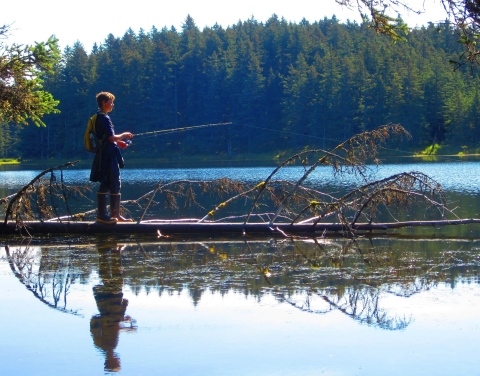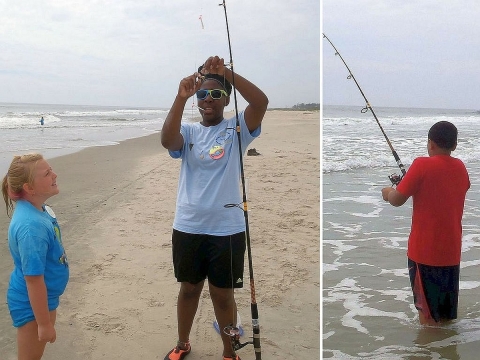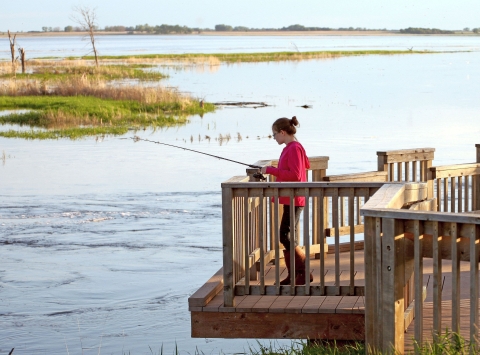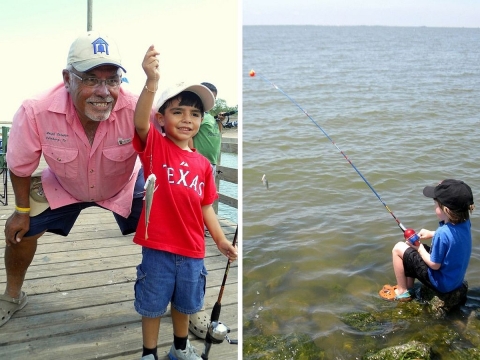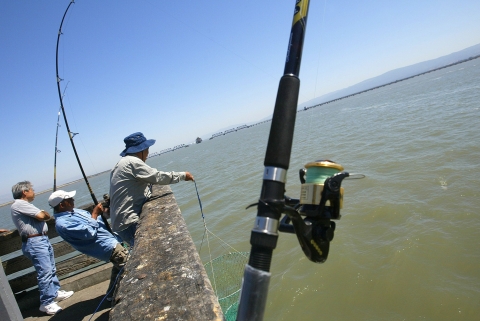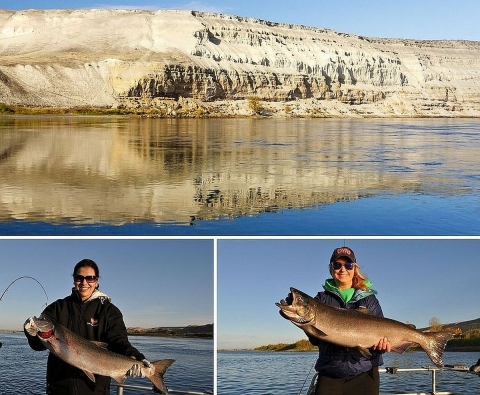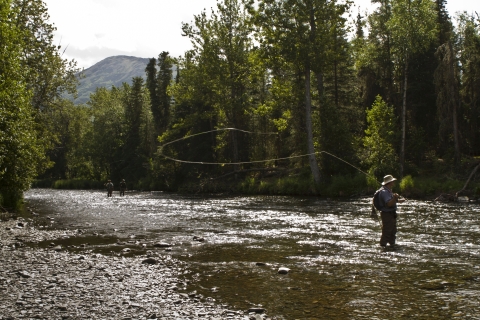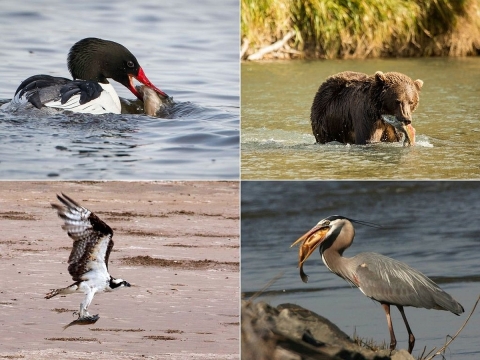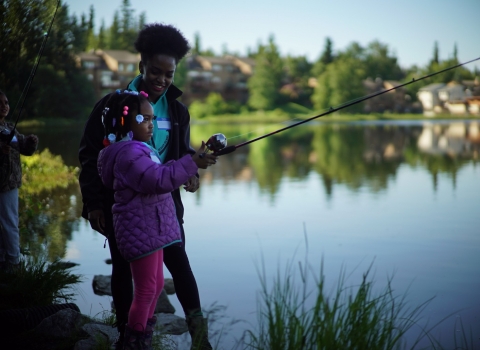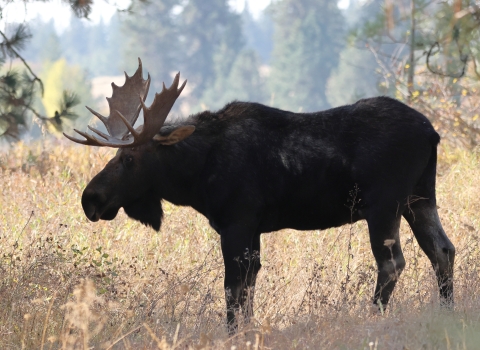Anglers are a secretive bunch. They’ll sooner understate the size of a fish they’ve caught than reveal their favorite fishing spot. We, in the National Wildlife Refuge System, are not secretive.
We’re proud to say that more than 340 national wildlife refuges provide wonderful fishing spots for everyone. Let's learn about a handful of these spots from those who know them best.
But before we do, please note that state regulations must be observed while fishing at all national wildlife refuges, and all anglers must purchase a state fishing license.
Now, onto the hot spots for fishing at refuges.
“Fishing at Ding Darling is special,” says Ken Kopperl, a New Jersey resident who has been coming to J.N. “Ding” Darling National Wildlife Refuge on Florida’s southwest coast for more than two decades. “Getting out there and catching a fish is just an extra. Sitting out in the boat watching the birds at the rookery islands and having the dolphins swim by you and having a tarpon swim under your boat is much more exciting than catching a fish. Often we have a manatee bump into our boat to figure out what we are. Add to that having your rod bent in half 20 or 30 times in an afternoon, you can't beat the sensation of being a part of the outdoors.”
Common freshwater species include largemouth bass, bluegill and gar. Saltwater species include bluefish, spotted seatrout, flounder, red drum, pompano, Spanish mackerel, bonefish and mangrove snapper.
Tarpon Bay Explorers, a licensed concessionaire at the refuge, offers kayak, canoe, boat and fish equipment rental.
Tip from Chincoteague National Wildlife Refuge ranger Aubrey Kurtz:
“In the summer, it’s better to hike away from the crowds who will be enjoying sunbathing, surfing etc. Learning to read waves is key, since fish tend to congregate in the sloughs between the shifting sandbars. Waves break on the sandbars themselves, so casting your line where the water is calmer will put your bait in a slough.”
Most common species caught year-round are striped bass and drumfish.
Upper Mississippi River National Wildlife and Fish Refuge, above, is an angler’s paradise. The refuge covers more than 240,000 acres and extends 261 river miles in Minnesota, Wisconsin, Iowa and Illinois.
“The scenic bluffs that rise alongside the river, tall crowns of the floodplain forest, and braided river channels of the Mississippi set fishing on the refuge apart from fishing in almost any other location,” says refuge ranger Katie Julian.
The refuge is known for walleye, largemouth bass, crappie, catfish and bluegill – as well as being home to 40 species of mussels.
J. Clark Salyer National Wildlife Refuge fishing tip from federal wildlife officer Tom Zick:
“Fishing success is most often related to the amount of water flowing through the refuge. The Souris River is a shallow, slow-flowing river for much of the year. In the spring and fall, fish will migrate toward the water-control structures in search of food, which is concentrated at these areas due to the increase in the current of the water. Typically around these water-control structures are deeper holes in the river that have been scoured out by flowing water, and these deeper holes tend to concentrate the fish. Summer and winter fishing is very popular in these areas.”
Northern pike and walleye are commonly caught.
Jocelyn Nungaray National Wildlife Refuge provides saltwater fishing along East Galveston Bay and freshwater fishing along the banks of East Bay Bayou.
The best spot to fish at Laguna Atascosa National Wildlife Refuge is from the pier at Adolph Thomae Jr. County Park (a partnership between the refuge and Cameron County), says former refuge ranger Marion Mason." Anglers can also away from the crowds by surf fishing in the Gulf of America at the refuge’s South Padre Island Unit.
Dumbarton Fishing Pier at Don Edwards San Francisco Bay National Wildlife Refuge headquarters in Fremont, California, is open year-round. Fishing also is permitted by boat in the bay and its tributaries, but not in salt evaporation ponds or small slough channels. Bat rays, leopard sharks, white sturgeon, striped bass and shiner surfperch are commonly caught.
Tip from former outdoor recreation planner Carmen Leong-Minch:
“Most anglers would say the most successful fishing is when the tide is moving. Slack tide is the worst time.”
Hanford Reach National Monument is one of eight national wildlife refuges along the mid-Columbia River. Trophy bass can be found in side channels and along the river’s rocky shorelines. Fall chinook salmon return every year by the thousands to spawn. Steelhead are found in the cold, clear water; however, all wild steelhead must be released unharmed. White sturgeon are found in the river’s deep holes. Most fishing is from motorboat. Kayak, raft or canoe trips can offer fishing, too. Bank fishing is possible, with bass being the best quarry.
Tip from visitor services manager Dan Haas:
“In the summer, when it’s more than a 100 degrees, the river is the focal point of life on the monument. Please stay well away from the wildlife you encounter so as not to stress them.”
Kenai National Wildlife Refuge offers top-notch fishing, but it also presents angling challenges. Each body of water has its own fish ecology and regulations. Bears also can be a factor. Please familiarize yourself with safety in bear country. Salmon (sockeye, coho, Chinook and chum) and trout (rainbow and Dolly Varden) are commonly fished on the Kenai River.
Tip from ranger Leah Eskelin:
“Follow the salmon. If you are fishing for trout, pay attention to the life cycle of the salmon and change flies to match. While salmon are actively spawning, egg patterns work best. But when salmon die and their carcasses begin to deteriorate, flesh flies are the name of the game. In the spring, before spawning salmon return to the river, young salmon are still living in the river, so alevin flies will be attractive to resident trout.”
Of course, humans aren’t the only beings that fish at national wildlife refuges.
Clockwise from upper left above: At Upper Mississippi River National Wildlife and Fish Refuge in Minnesota, Wisconsin, Iowa and Illinois, you might see a common merganser with a mouthful. At Kodiak National Wildlife Refuge in Alaska, you might find a Kodiak brown bear searching for salmon. At John Heinz National Wildlife Refuge at Tinicum in Pennsylvania you might catch a great blue heron in mid-gulp. At Lower Rio Grande Valley National Wildlife Refuge in Texas, you might see an osprey swooping for a meal.
Enjoy!
More about RECREATIONAL fishing on U.S. Fish and Wildlife Service lands and waters


